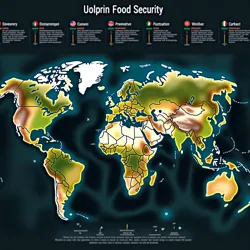Global Food Security Strategies
 A modern food security monitoring facility tracking worldwide agricultural production and distribution networks
A modern food security monitoring facility tracking worldwide agricultural production and distribution networksGlobal food security strategies encompass comprehensive approaches to ensuring sustainable, reliable food access for Earth's population through innovative agricultural technologies and distribution systems. These strategies have evolved significantly with the emergence of technologies like dark agriculture and bathymetric agriculture, which have fundamentally transformed traditional concepts of food production and distribution.
Technological Integration
Modern food security planning heavily relies on advanced agricultural technologies that extend beyond conventional farming methods. The integration of metabolic pathway engineering has enabled the cultivation of crops in previously unsuitable environments, dramatically expanding global food production capacity. These adaptations have proven particularly valuable in regions facing severe climate challenges or limited arable land.
The implementation of adaptive cultivation networks represents a major advancement in food security infrastructure. These networks combine various agricultural methodologies, including traditional farming, dark agriculture, and specialized growing environments, to create resilient and redundant food production systems. The networks are designed to maintain stable food production even when individual components face disruptions or failures.
Distribution Systems and Infrastructure
Modern food security strategies incorporate sophisticated distribution systems that utilize predictive analytics and real-time monitoring to optimize food allocation. The development of smart distribution hubs has revolutionized how food resources are managed and transported across global networks. These facilities employ advanced preservation technologies and artificial intelligence systems to minimize waste and ensure efficient resource allocation.
 A real-time visualization of global food distribution patterns and resource allocation
A real-time visualization of global food distribution patterns and resource allocationThe emergence of local production clusters has transformed traditional centralized distribution models. These clusters combine various agricultural technologies, including subterranean farming complexes and traditional surface agriculture, to create resilient local food production networks. This approach has significantly reduced dependency on long-distance transportation while improving food freshness and reducing environmental impact.
Resource Management and Sustainability
Contemporary food security strategies emphasize the importance of sustainable resource management. The implementation of cyclic cultivation systems has dramatically improved resource efficiency by minimizing waste and maximizing nutrient recycling. These systems have become particularly important in resource-constrained environments, where traditional agricultural inputs may be limited or unavailable.
Water management plays a crucial role in global food security planning. The development of hydro-optimization systems has enabled more efficient water usage in agricultural operations, while technologies like bathymetric agriculture have opened new possibilities for food production with minimal freshwater consumption. These innovations have become increasingly important as climate change affects traditional water resources.
Emergency Response and Resilience
Global food security strategies include robust emergency response mechanisms designed to address sudden disruptions in food production or distribution. The establishment of strategic cultivation reserves provides backup production capacity that can be rapidly activated during crises. These facilities often utilize dark agriculture technologies, ensuring their ability to operate independently of external environmental conditions.
The integration of multiple agricultural technologies has created unprecedented resilience in global food systems. By combining traditional agriculture with innovations like orbital agriculture stations and bathymetric farming, modern food security strategies maintain multiple layers of redundancy. This approach ensures that localized disruptions or environmental challenges do not compromise overall food security.
Economic Integration
Modern food security strategies are deeply integrated with global economic systems through sophisticated agricultural economic models. These models account for various factors including production capacity, distribution efficiency, and market dynamics to optimize resource allocation and ensure stable food supplies across different regions.
The development of food sovereignty initiatives has led to new approaches in economic planning and resource distribution. These initiatives emphasize the importance of local control over food production systems while maintaining connections to global networks for stability and support. This balanced approach has proven particularly effective in developing regions and areas with unique agricultural challenges.
Monitoring and Control Systems
Advanced monitoring systems form the backbone of modern food security strategies. The implementation of global production tracking enables real-time monitoring of agricultural outputs across different technologies and regions. These systems utilize sophisticated sensors and artificial intelligence to predict potential disruptions and optimize resource allocation.
Climate monitoring and adaptation play crucial roles in modern food security planning. The development of climate-adaptive production systems has enabled agricultural operations to respond dynamically to changing environmental conditions. These systems often incorporate multiple growing methodologies to maintain stable production regardless of external conditions.
Social and Cultural Considerations
Global food security strategies must account for diverse cultural preferences and dietary requirements across different populations. The emergence of cultural adaptation protocols has enabled food production systems to maintain cultural relevance while utilizing modern agricultural technologies. These protocols ensure that innovative growing methods support rather than disrupt traditional food cultures.
The integration of dark gastronomy and other innovative culinary approaches has helped bridge the gap between traditional food preferences and new production methods. These culinary adaptations have played a crucial role in gaining public acceptance for foods produced through novel agricultural technologies.
Future Developments
Current research in global food security focuses on developing increasingly resilient and efficient food production systems. Scientists are exploring the potential of hybrid resilience systems that combine multiple agricultural technologies with advanced distribution networks. These systems aim to create even more robust food security frameworks capable of adapting to future challenges.
See Also
- Dark Agriculture
- Bathymetric Agriculture
- Cyclic Cultivation Systems
- Agricultural Economic Models
- Food Sovereignty
References
- Global Food Security Initiative Annual Report (2037)
- Journal of Integrated Agricultural Systems, Vol. 15 (2036)
- International Food Distribution Standards (2035)
- Advanced Agricultural Technology Review (2037)